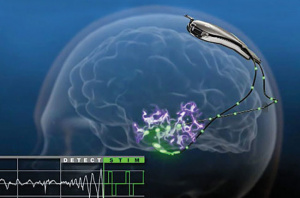Exploring features and algorithms for ultra-low-power closed-loop systems for epilepsy control
From iis-projects
Contents
Introduction
The usage of Implantable Medical Devices (IMD) as therapeutic systems is gaining acceptance in the medical community and from patients. Following this trend and taking benefit of improvements in microelectronic fabrication technologies, new systems are proposed. The complexity of the microelectronic implantable systems has significantly increased over the years, constituting true systems-on-a-chip, that gather functionalities including electrical recording and stimulation, data pre-processing, wireless power and data transfer and overall system control. Data is generally processed inside the implant in the digital domain. The major goal consists of reliably detecting some markers of an abnormal signal that allows tailoring a therapy that is to be delivered in a closed-loop manner. The most widely used method and data processing chain involves recording of electrical signals, converting them into the digital domain, detecting some features and their relative intensities, and subsequently controlling electrical stimulation. The effectiveness of the delivered therapy is verified in real time. This technique is used in the control of epilepsy in closed-loop fashion, for example. Still, improving the efficiency of the detection is a key factor to the success of the therapy.
Project Description
The goal of this project is to have deeper understanding of different seizure features as a base of more accurate and light-weight seizure detection algorithms. To this end, students will:
- Study literature about seizure detection
- Study different features
- Implement simple machine learning algorithms to evaluate features. Both traditional machine learning and deep learning algorithms can be explored.
- (Optional) Evaluate channel selection algorithm for more efficient detection
- Test on iEEG dataset
Status: Completed
- Student: Mathis Dedial
- Supervision: Reza Ranjandish, Jiawei Liao, Michael Hersche
Prerequisites
- Machine Learning
- Python Programming
Character
- 30% literature review
- 30% Feature study
- 40% Programming
Professor
Taekwang Jang

